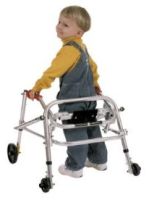Disabled children, like normal children, crave mobility. The best type of walker for a child depends on the degree of mobility he has and whether he still has adequate upper body strength to propel a device. Handicap walkers should be chosen only after careful consideration of the child’s needs by his physician and physical therapy team.
Walkers expand a disabled child’s world by allowing them to take trips outside the house and go to school. A walker also allows the child to maintain muscle mass and prevent atrophy through weight-bearing exercise, to the degree that the child can participate. These walking equipment for disabled children are intended to reduce the amount of energy used in order to walk properly. This allows for a focus on proper posture and practicing the movements of walking without expending too much energy in the process.
Trainer Walkers
 rainer walkers are designed for children who can walk assisted with additional support. They are great for children who are unable to stand on their own. The trainer walker normally provides a seat for resting when needed as well as chest and pelvic support. Also known as gait trainers, trainer walkers are priced between $400 and $800 on average.
rainer walkers are designed for children who can walk assisted with additional support. They are great for children who are unable to stand on their own. The trainer walker normally provides a seat for resting when needed as well as chest and pelvic support. Also known as gait trainers, trainer walkers are priced between $400 and $800 on average.
Swivel Walkers
 Several types of walkers may be called swivel walkers. Some are just walkers with wheels that turn in all four directions. Children don’t have to pick up and reposition their walker when they want to change direction. A swivel walker’s front wheels can be locked to avoid loss of control of the walker.
Several types of walkers may be called swivel walkers. Some are just walkers with wheels that turn in all four directions. Children don’t have to pick up and reposition their walker when they want to change direction. A swivel walker’s front wheels can be locked to avoid loss of control of the walker.
The term swivel walkers is also used to describe a special type of walker used for children with spina bifida and other disorders that cause immobility of the hips and legs. A child moves the unit, which straps on to the child, by rocking from side to side, which swivels one foot at a time forward. Also called an ORLAU swivel walker, these units are primarily designed for indoors. These devices can bear some of the weight of the child as they walk.
Any type of mobility device will require regular maintenance to ensure that the child will not injure himself using the device. For devices that must be specially fitted to the child, the fit must be assessed on a regular basis as well.
